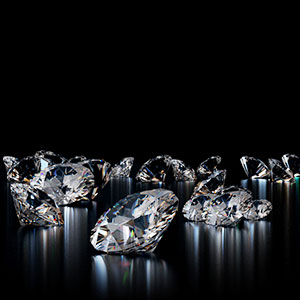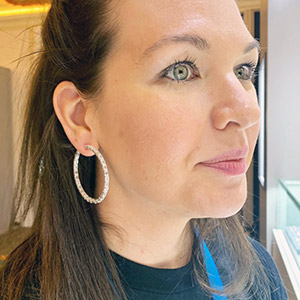
This week, as part of its 14th package of sanctions in response to Russia’s invasion of Ukraine, the European Union (EU) announced it was postponing its proposed G7 diamond certification scheme by six months, until March 2025.
This was big news, but not unexpected. The scheme aimed to certify the non-Russian origin of every diamond one-half carat and above on a blockchain-based ledger. The ledger would be backed up by a visual inspection at Antwerp’s Diamond Office, which would act as the scheme’s “rough node.” Each package would be given a certification number, which other import hubs (like the United States) could refer to.
This plan was clearly too ambitious to be operational by September. It’s currently being piloted, but on a very limited basis. For it to suddenly handle a huge number of diamonds would require an extremely quick scale-up. And it’s still not clear who will pay for it.
Some even argue it won’t provide the transparency the industry needs.
“When people hear traceability, they assume it goes to a stone level,” says one person involved in the discussions. “In February, there was a roundtable hosted by the AWDC [Antwerp World Diamond Centre]. And when people looked under the hood, they saw this didn’t even equal a crude level of traceability. Once it leaves Antwerp, it can be mixed, and you can’t doubt it because it has the G7 sticker on it.”
The EU says it’s still interested in a “traceability scheme,” but some believe it won’t opt for a centralized tracking system as currently envisioned. Instead, companies might be allowed to run their own processes, as long as they meet certain standards. That could eliminate the need for “nodes,” the part of the plan that has seriously ticked off African governments.
Along with the delay, the EU also announced it would allow imports of “grandfathered” stock, provided there’s evidence it was purchased prior to March (for 1 ct.-and-up diamonds) or September (for a half-carat and up). This follows guidance that the United Kingdom first put into place in March, and will help some Antwerp companies, which have exported old goods to India to be cut, but haven’t been able to import them back.
The EU also postponed planned restrictions on diamond jewelry imports, possibly for good. (Even the EU’s node of choice, the Antwerp Diamond Office, says it has no way to evaluate jewelry.) It’s also given its blessing to “temporary imports or exports of jewelry … for trade fairs or repairs.” Sources say that clause was pushed by France, home to some of the world’s biggest luxury companies, and an increasingly vocal player in the discussions.
“That’s very relevant for the heritage brands,” says an industry member who’s talked with the governments. “Let’s say you have an antique Van Cleef piece, and you want to get it repaired by Van Cleef in France. You wouldn’t necessarily have its original Kimberley Process certificate.” (The Kimberley Process was established in 2003.)
So far, the EU is the only G7 member that has announced its intentions for September. But it’s considered the driving force behind Russian diamond sanctions, so it’s likely the rest of the G7 will follow its lead, and may even expand some of its exemptions. (G7 nations try to coordinate policy, but ultimately act independently.)
Many are watching the United States, the world’s largest diamond market. While the U.S. was originally quite engaged on the diamond issue, it has since receded a bit. It has released very few official statements on Russian diamonds, and those have all been quite general.
Earlier this year, the U.S. Office of Foreign Assets Control (OFAC) declared that, beginning March 1, Russian-mined diamonds 1 ct. and above would be blocked from entering the United States, even if polished elsewhere, and the ban will extend to diamonds 0.5 ct. and above on Sept. 1. That’s in line with the G7’s road map.
However, unlike the EU, which currently requires “documentary evidence” of every diamond’s origin, the United States has allowed importers to “self-certify” gem provenance. There’s no word on whether that will change in September, when the carat threshold is due to drop.
The United States also hasn’t made any statement on grandfathered goods, but those involved in lobbying efforts—and there have been quite a few—say the Biden administration and members of Congress have been receptive to the trade’s point of view.
For all the questions that have now been answered, plenty remain, and that’s after more than a year of consultations and discussions. Some wonder whether the new one-half-carat cutoff will apply to both rough and polished. They say that half-carat rough generally yields melee, which is not particularly profitable, and is too voluminous to police.
The EU has also said that lab-grown diamonds will be subject to the new restrictions. And while it walked back a few things this week, it made no mention of that, and sources say that’s still in the mix. That won’t be a big deal in Belgium, which doesn’t import a lot of lab-grown. But it could cause headaches if the United States adopts it too.
Most synthetics are grown in India and China, then shipped to America. In that case, importers would simply need to provide proof of where they were produced. But if a company grows them domestically, cuts them abroad (like Lightbox and Diamond Foundry), then reimports them, that may require a longer paper trail. That’s all doable, if not quite as smooth and easy as before.
Already, there’s anecdotal talk of diamond imports being held up by U.S. Customs, and at the border in Frankfurt, Germany. The current sanctions may not be as bad as some in the industry first feared, but they are a major change in how the industry works, and their implementation has not been seamless. The sanctions coming in September have already been scaled down, but they could bring their share of challenges too.
Credit: Getty Images
Follow JCK on Instagram: @jckmagazine
Follow JCK on Twitter: @jckmagazine
Follow JCK on Facebook: @jckmagazine







